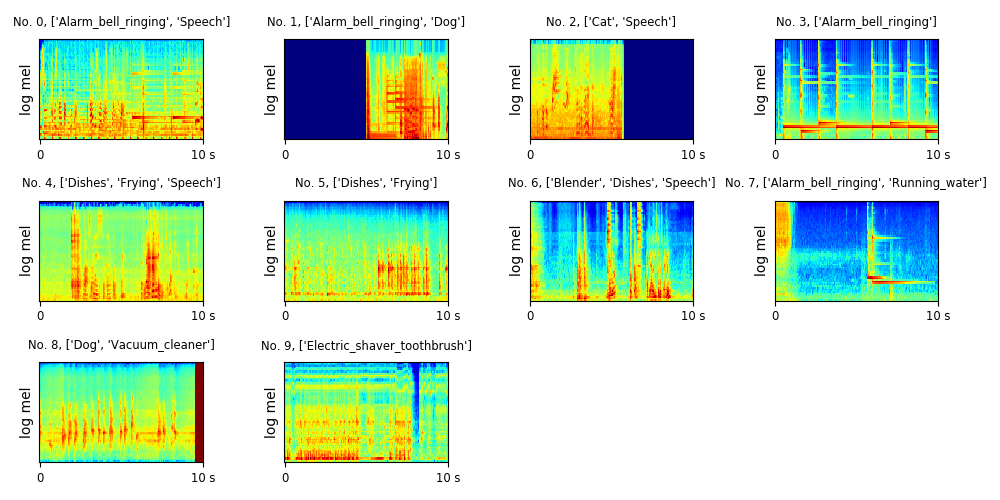DCASE 2018 Task 4 Large-scale weakly labeled semisupervised sound event detection in domestic environments
DCASE 2018 Task 4 is the large-scale detection of sound events using weakly labeled data. There are 10 sound classes including 'Speech', 'Frying', 'Vacuum_cleaner', etc. We provide a convolutional neural network (CNN) baseline system implemented with PyTorch in this code base. More details about this challenge can be found http://dcase.community/challenge2018/task-large-scale-weakly-labeled-semi-supervised-sound-event-detection
The dataset is downloadable from http://dcase.community/challenge2018/task-large-scale-weakly-labeled-semi-supervised-sound-event-detection
Each audio clip is around 10 second.
The development data consists of 1578 weakly labeled audio clips, 14412 unlabel in domain audio clips, 39999 unlabeled out of domain audio clips and 288 audio clips with strong labels for development. The evaluation data consists of 880 audio clips. Each audio clip last for around 10 seconds.
| Number of audios | |
|---|---|
| Train (weak) | 1578 |
| Train (unlabel_in_domain) | 14412 |
| Train (unlabel_out_of_domain) | 39999 |
| Test (strong) | 288 |
| Evalutation | 880 |
The log mel spectrogram of the scenes are shown below:
The audio names are:
No. 0, YKK227gPpRn4_30.000_40.000.wav No. 1, Y44U-fF5rsjM_0.000_10.000.wav No. 2, Y0632OqvXrwg_7.000_17.000.wav No. 3, Y-6p32k2WUCs_0.000_10.000.wav No. 4, Y5_OJsj6bcuo_260.000_270.000.wav No. 5, Y8EQHKEd5mm4_120.000_130.000.wav No. 6, Yhtox2pJ-XVs_190.000_200.000.wav No. 7, YmOfTDGOGBpI_160.000_170.000.wav No. 8, Y0_J0BWiW7-k_12.000_22.000.wav No. 9, Y7yeWLEus7OI_80.000_90.000.wav
Prepare data. Download and unzip the data. The data looks like:
. ├── audio │ ├── train │ │ ├── weak (1578 audios) │ │ │ └── ... │ │ ├── unlabel_in_domain (14412 audios) │ │ │ └── ... │ │ └── unlabel_out_of_domain (39999 audios) │ │ └── ... │ ├── test (288 audios) │ │ └── ... │ └── eval (880 audios) │ └── ... ├── metadata │ ├── train │ │ ├── weak.csv │ │ ├── unlabel_in_domain.csv │ │ └── unlabel_out_of_domain.csv │ ├── test │ │ └── test.csv │ └── eval │ └── eval.csv └── ...
1. (Optional) Install dependent packages. If you are using conda, simply run:
$ conda env create -f pytorch/environment.yml
$ conda activate py3_dcase2018_task4
(We developed this system with python 3. If you are using pytorch as backend then pytorch 0.4.0 is required.)
2. Then simply run:
$ ./runme.sh
Or run the commands in runme.sh line by line, including:
(1) Modify the paths of data and your workspace
(2) Extract features
(3) Train model
(4) Evaluation
We validate the average precision (AP) and area under the curve (AUC) during training. The training looks like:
root : INFO Loading data time: 1.390 s root : INFO Training audios: 1578 root : INFO Validation audios: 288 root : INFO iteration: 100, train time: 13.633 s, validate time: 1.027 s root : INFO tr_ap: 0.652, tr_auc: 0.907, tr_loss: 0.256 root : INFO va_ap: 0.609, va_auc: 0.879, va_loss: 0.272 root : INFO root : INFO iteration: 200, train time: 13.807 s, validate time: 1.045 s root : INFO tr_ap: 0.828, tr_auc: 0.961, tr_loss: 0.180 root : INFO va_ap: 0.713, va_auc: 0.918, va_loss: 0.226 ...... root : INFO iteration: 5000, train time: 15.669 s, validate time: 1.133 s root : INFO tr_ap: 1.000, tr_auc: 1.000, tr_loss: 0.003 root : INFO va_ap: 0.781, va_auc: 0.930, va_loss: 0.260
We apply a convolutional neural network on the log mel spectrogram feature to solve this task. Training takes around 200 ms / iteration on a GTX Titan X GPU. The model is trained for 5000 iterations. The result is shown below. We use mean average precision (mAP) to evaluate audio tagging (AT) and F score to evaluate sound event detection (SED).
| AT (mAP) | SED_1 (F score) | SED_2 (F score) | |
|---|---|---|---|
| Speech | 0.848 | 0.0% | 15.1% |
| Dog | 1.000 | 2.5% | 5.1% |
| Cat | 0.952 | 3.4% | 6.8% |
| Alarm bell ringing | 0.929 | 4.2% | 15.3% |
| Dishes | 0.607 | 0.0% | 2.2% |
| Fryining | 0.639 | 50.0% | 2.1% |
| Blender | 0.504 | 21.8% | 4.7% |
| Running water | 0.821 | 11.3% | 8.2% |
| Vacuum cleaner | 0.808 | 60.3% | 9.9% |
| Electric shaver toothbrush | 0.704 | 41.0% | 20.0% |
| Average | 0.781 | 19.46% | 8.94% |
This codebase provides a convolutional neural network (CNN) for DCASE 2018 challenge Task 4.
"Kong, Qiuqiang, Turab Iqbal, Yong Xu, Wenwu Wang, and Mark D. Plumbley. "DCASE 2018 Challenge baseline with convolutional neural networks." arXiv preprint arXiv:1808.00773 (2018)."
If you met running out of GPU memory error, then try reduce batch_size.
The official baseline system implemented using Keras can be found https://github.com/DCASE-REPO/dcase2018_baseline
